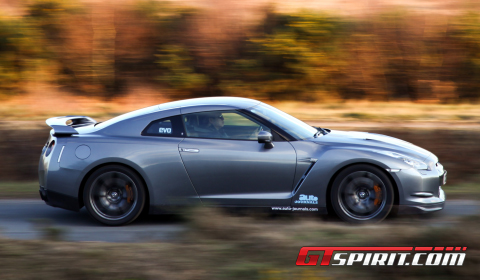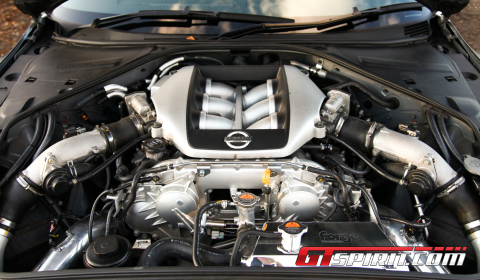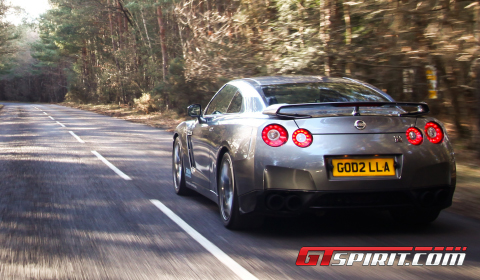Godzilla has returned into the hands of a supercar owner who invited us for a first drive of his current tuning project in Surrey, UK. David Yu is an automotive journalist for Auto-journals.com and a known person within the British GT-R scene. Twelve years after nearly bankrupting himself with the tempestuous Skyline R33 GT-R, he found himself the courage to start a new project, one based on the Nissan R35 GT-R.
The Nissan R35 GT-R has established a solid fan base over the past few years and opened up possibilities for companies to develop tuning programs for the Japanese sports car. The GT-R’s price tag and capabilities make it a wonderful starting point for supercar tuning, achieving figures only possible in the hypercar range. As a basic setup the Nissan sports car is a twin-turbocharged four-wheel-drive machine, a car that must be experienced by any car enthusiast.
The endless improvements from within Nissan will not come to a halt any time soon, on the contrary they provide us with a clear insight that new possibilities will arise over the coming years. This is fed by the ongoing list of tuners that offer programs for the car, like the Switzer P800 we drove in 2011. The wide range of choice for current and future GT-R owners is still growing by the day, not making the right tuning decisions much easier.

For David the choice was clear! The basis for success is his current 2009/2010 Nissan R35 GT-R fitted with an appropriate license plate referring to the car’s nickname. On both performance and cosmetic levels things have changed within his GT-R package, improving weak points in the design and pushing the boundaries forward. The current powertrain modifications are not the last Yu will install on his car, but they do show that by simply changing a few settings a new world can open up.
The increased performance, up to 620hp and 620lb-ft of torque, has been achieved by installing a range of Cobb, Forge and Akrapovic goodness. The engine injectors were replaced with ID1000 1000cc/min injectors from Injector Dynamics. GTC 76mm air intake pipes with K&N cone filters were installed. To shed some weight at the rear and to increase the power slightly, Akrapovic delivered their Evolution titanium exhaust system with carbon fiber tips for journalist’s second Godzilla project. The increased performance is noticeable with respect to the stock setup. The initial lift-off feels a lot more swift and the darker sound track from the back is much more prominent.
The Cobb Accessport 006 provided access into the ECU. The system was used to upload new engine files tuned by Cobb guru Ben Linney from GTC Racing Technology. The 2011MY gearbox software with LC4 launch control was installed using the Cobb Transmission Control Module. The shifting goes faster and smoother. The supercar pulls away much more smoothly from rest at slow speeds and has the ability to select first gear manually whilst slowing down approaching a junction or roundabout. This is something that was at best a rather hit and miss affair with the original software, according to Yu.

Via Litchfield Import, the independent GT-R service centre of choice in Gloucestershire, Yu installed his latest addition to the twin-turbocharged engine, a Forge Motorsport transmission cooler and alloy header tank. The Forge Motorsport cooler uses a high quality Mocal core with custom Aeroquip hoses and fittings and a powerful Mocal pump capable of passing the entire ten liters of fluid (two more than standard) through every minute, achieving a better cooling when the car is thrown around the track. The shiny alloy coolant header tank is easily visible in the engine bay.
Litchfield also supplied a pair of Alcon discs that are both lighter and stronger than the Nissan/Brembo standard items. At the front the GT-R uses Alcon 400mm discs, which are 20mm bigger than standard – yet weigh a scarcely believable 1.6kg less each. At the back a similar setup was fitted in a standard size. Four carbonetic Spec R pads, Motul brake fluid and Goodridge stainless steel Teflon brake lines complement the improved braking kit. The pads have an incredible bite, even from cold, and absolutely refuse to fade, giving a consistent response.
The cosmetic upgrades to the car are a carbon front grille, Auto Select carbon bonnet vents and carbon front canards, a RSW carbon interior trim for the center console and gearshift surround.

The two hours inside the tuned Nissan GT-R told us that it had been drastically changed. The improvements and changes added by David meant that he tuned the characteristics of the stock setup in a favorable way. The Toyo R888 20 inch tyres played a major role in the improved grip, but the most noticeable difference where the faster gear changes due to the upgraded gearbox software and the additional oomph provided by the 3.8 liter V6 engine.
The project continues! Since our drive a few weeks ago he installed a Valet Magic Stealth Zilla part matte clear wrap, Michelin Super Sport tyres in OEM sizes (255/40 20 and 285/35 20) and a JM carbon fiber steering wheel. A Litchfield Bilstein/Eibach suspension is planned for the near future. Eventually, when funds allow, he plans to fit forged pistons/rods and slightly larger turbos to go to a maximum performance of 850hp. The amazing thing is, the car can handle that level of power easily as long as you include some essential changes to the weak spots of the car.





































Some fantastic photos there. Big thumbs up to Christian!
Nice!!